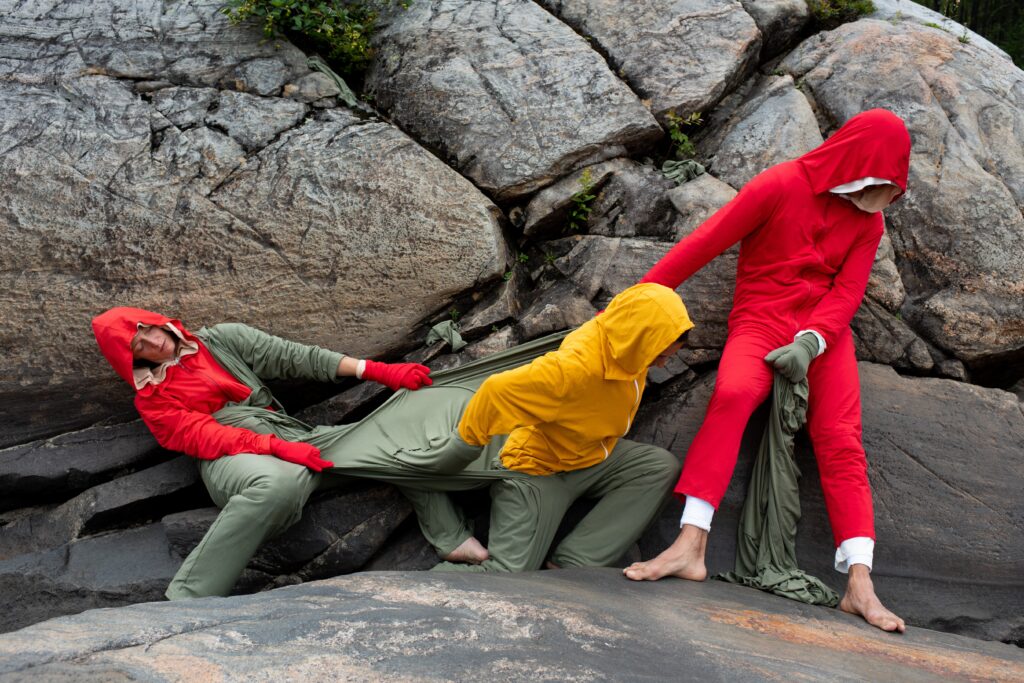(English version follows)

Le projet se traduit par des chorégraphies sobres exécutées dans la nature sauvage de la région du Saguenay-Lac-Saint-Jean*. Intervention légère et respectueuse de l’environnement, cette dernière n’a laissé derrière elle que des traces documentaires sous forme de vidéos et de photographies. Plus précisément, les chorégraphies se déclinent en une série de performances; sortes de tableaux vivants à l’intérieur desquelles des danseurs professionnels revêtent des « survêtements-peaux », que j’ai confectionné, afin d’expérimenter les notions de frontière, de territoire, de paysage et d’identité. Je voulais ainsi articuler une réflexion sur « la nature comme ouverture au monde » et que, de ces explorations artistiques, se manifeste un désir de découverte et de liberté ainsi qu’une plus grande conscience de notre échelle humaine par rapport aux arbres, aux rochers et autres éléments des paysages naturels.
Ce projet se décline en 3 phases. La première consistait à préparer le terrain de création. Cela s’est traduit notamment par la confection de survêtements, la recherche de lieux et l’élaboration d’une chorégraphie. La deuxième phase s’est manifestée à travers l’exécution d’une série de performances in situ. Ces dernières ont été méticuleusement documentées à l’aide de captations vidéo et de photographies. S’articulant sous le thème : « Quête de territoire et écologie de la liberté et du vivre ensemble », ces performances in situ ont pris la forme de chorégraphies sauvages lors desquelles les performeurs se sont approprié le paysage. Micro-événements accomplis dans des lieux sans spectateurs, ces performances n’ont laissé aucune trace derrière elles. Enfin, la troisième phase est la synthèse et l’aboutissement des deux étapes précédentes. Celle-ci prendra la forme d’une installation multidisciplinaire: vidéo, photographies et installation textile.
Mon projet se veut foncièrement multidisciplinaire et collaboratif. De ce fait, j’ai d’abord invité la chorégraphe Sarah Bild à créer une performance incarnant la lenteur, la quête de légèreté et la confrontation avec soi-même. J’ai ensuite sollicité la participation des danseurs Sara Hanley, Maria Kefirova et James Viveiros qui, vêtus des vêtements-peaux que j’ai confectionnés pour eux, ont donné corps à la chorégraphie et à ma réflexion artistique. Enfin, selon mes instructions et sous ma direction, le cinéaste Marc-André Bernier et le photographe Simon Émond ont documenté les performances afin que j’aie tout le matériel visuel nécessaire à la production de mon oeuvre installative finale. La trame sonore de la vidéo est réalisée par le musicien David Ryshpan.
*Cette micro-résidence d’une durée d’une semaine au secteur de l’Énergie du Parc Régional des Grandes-Rivières, a été réalisé grâce à une bourse de création du Conseil des arts du Canada et d’un partenariat avec le Parc Régional des Grandes-Rivières. Mon équipe et moi, avons campé sur place.

The Stripping of the Eel
The essence of the project is expressed through sober choreographies performed in the wilderness of the northern Lac-Saint-Jean region, in Quebec. This light and environmentally friendly intervention leaves behind only documentary traces in the form of videos and photographs. More precisely, the choreographies are declined in a series of performances; a sort of living tableaux in which professional dancers put on “sweat-suits”, made in order to experiment the notions of border, territory, landscape and identity. I wanted to articulate a reflection on “nature as an opening to the world” and that, from these artistic explorations, a desire for discovery and freedom would emerge as well as an increased awareness of our human scale in relation to trees, rocks and other elements of the natural landscape.
This project is divided into 3 phases. The first phase consisted in preparing the ground for creation. This involved making tracksuits, finding locations and developing choreography. The second phase manifested itself through the execution of a series of in situ performances*. These performances were meticulously documented through video and photographic recordings. Articulated under the theme: “Quest for territory and ecology of freedom and living together”, these in situ performances took the form of wild choreographies during which the performers appropriated the landscape. Micro-events accomplished in places without spectators, these performances left no tangible trace behind. Finally, the third phase is the outcome of the two previous stages. It takes the form of a multidisciplinary installation: video, photographs and textile installation. I solicit your center to welcome and allow this project to invest both concretely and symbolically the territory by the installation and the diffusion of this fleeting work. The public will be invited to put on and take off one by one the tracksuits to experiment the performative aspect of the project by being inspired by the video.
My project is fundamentally multidisciplinary and collaborative. Therefore, I first invited choreographer Sarah Bild to create a performance embodying slowness, the quest for lightness and the confrontation with oneself. I then invited the dancers Sara Hanley, Maria Kefirova and James Viveiros to participate, who, wearing the clothes I made for them, gave substance to the choreography and to my artistic reflection. Finally, under my direction, filmmaker Marc-André Bernier and photographer Simon Émond documented the performances so that I would have all the visual material necessary to produce my final installation work. The soundtrack of the video is produced by musician David Ryshpan.
*This one-week micro-residency in the Energy sector of the Parc Régional des Grandes-Rivières was made possible by a Canada Council for the Arts creation grant and a partnership with the Parc Régional des Grandes-Rivières. My team and I camped on site.








